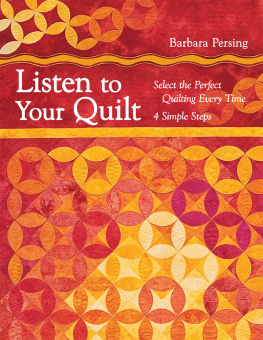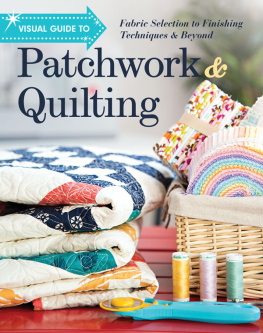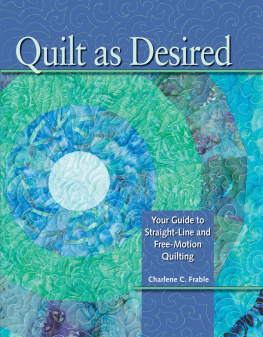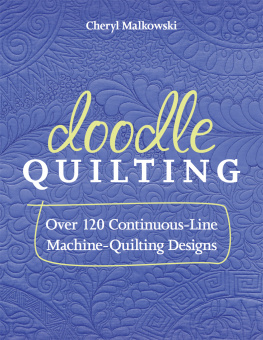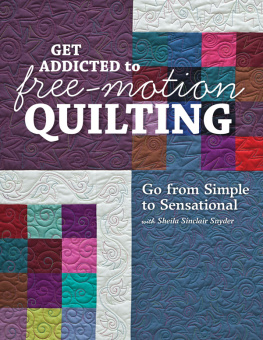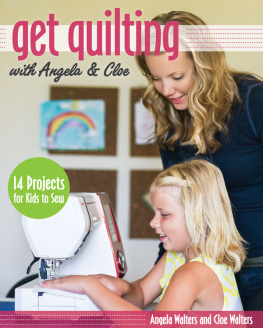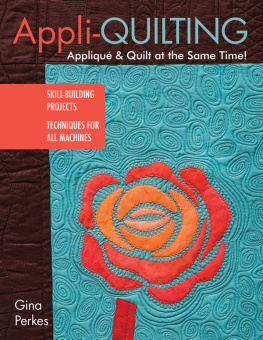Dedication
I dedicate this book to:
My best friend
My complementary puzzle piece
My inspiration
My reality check
The one who can read my mind
The one I can have an entire conversation with through just one look
The one I owe my success to
My sister
Mary Hoover
Acknowledgments
Writing a book takes a village! And I am very blessed to have a great village. I need to thank my husband of 30 years, Paul. He has been my cheerleader, champion, and friend from the very beginning. Where did those 30 years go? Weve had so much fun! And to my sons, Kyle and Quinn, who brighten my worldyou are very patient and know more about quilting than most men. I love you.
To the C&T familyfor being so supportive, encouraging, and talented. You are a joy to work with, and you make the daunting task of writing a book less overwhelming. Your expertise and experience are beyond measure.
To my momfor the beautiful example she sets as a mother and friend, for teaching me to sew, and for giving me the best friends and support group I will ever havemy siblings, Ann, Kathy, Jeanne, Michael, and Mary.
To my clientswithout whom I would not be the quilter I am todayyou have supported me and challenged me to be my best. Thank you for allowing me to collaborate on all your beautiful quilts.
Thank you all for being part of my village.

Introduction
As soon as the piecework is done and your quilt top is finished, does panic set in? Do you ask yourself, How should I quilt this quilt? No matter what technique we usedomestic machine, longarm machine, or hand quiltingwe all face the same question. My years as a longarm quilter have helped me find a unique approach for choosing the best quilting designs. Its simple and straightforward, and everyone can implement it.
Every time I am ready to begin quilting, I ask myself the same four questions. By answering these questions, I have a clear idea of how I want to quilt any quilt and which thread to use. This book will take you through these steps and show you how to apply this knowledge to your quilts.
All of the quilting ideas in this book are created free motion and require no marking tools. Most of these designs can also be done in a continuous line. Whether you are looking for simple allover designs or custom heirloom quilting, you will find plenty of ideas in this book.
So read on and begin to master your quilting design skills.
Developing Your Quilting Skills
My Path
I did not start my career as a longarm quilter. Like most people, I have had a number of careers, and only due to circumstance and persistence did I end up here. In the early years of my marriage, my husband and I lived in New Hampshire. I worked as a respiratory therapist for six years and enjoyed my work very much. We then had the opportunity to move back to the Philadelphia area and be close to our families. Even though I had enjoyed my previous career, I decided to make a change and went to work for a large group of orthopedic surgeons. I helped them establish a new practice, and I managed the daily office operations. This job was challenging and always changing. However, during the years I worked for them, I started a family and was looking for another change. I wanted a job that would allow me to be home with my young family.
I suggested to my husband that I resign my position, start my own business, and buy a really big quilting machinea longarm machine. He was a little skeptical but gave me all of his support. That was in May of 2000, and I have been running my longarm machine quilting business ever since.
To keep me on my toes, my sister Mary Hoover and I then formed a partnership and started our own pattern company, Fourth and Sixth Designs. We also wrote a book, StrataVarious Quilts, published by C&T Publishing. Luckily, I have had the pleasure of sharing these jobs with my sister. She is an excellent partner who, like me, has an obsession with quilting.
I had convinced my husband about this new career and about buying this big quilting machine, but there was one concern: I did not machine quilt! Even though I had been making quilts as a hobby, I had never machine quilted. I had always hand quilted the tops and didnt know a lot about machine quilting. So I did my research, went to local quilt shows, and tried out all the longarm machines. I talked to anyone who knew anything about the machines and chose the machine that I thought best suited my purposes.
I ordered my machine and was so eager for delivery that I started making quilt tops. I also had Mary piecing tops in New York. I needed many pieced quilt tops on which to practice before venturing onto clients quilts. My machine was delivered and set up in my home, and then I had about two hours of instruction before the machine representative left. Wait a minuteI was on my own!?
Like most longarm quilters, I first learned to quilt using pantograph designs. A pantograph design is a quilting design drawn on a long roll of paper that you follow with a laser pointer.

Pantograph design
Pantograph designs are quilted as you stand in the back of the machine; you do not face the quilt. This means the quilting is done with no regard to the piecework.

Working from the back of the machine
Following the pantograph designs taught me how to control the motion of my machine and how to be consistent with speed and stitch length. All of this is a very important part of getting comfortable with a longarm machine.
I had practiced and was now ready for clients. I looked forward to starting my new business and leaving behind all day-to-day decision making that came with office management. I thought that when I received quilts, my customers would tell me how they wanted their quilts quilted. My first client came to my house and showed me her quilt; when I asked how she wanted it quilted, she said, I dont know. Youre the expert. I didnt see that coming. I thought customers would make all the quilting decisions, and I would do the quilting. Machine quilting was fairly new to me, so I just chose the best pantograph design. After a couple of months of using pantographs, however, I found that this redundant quilting process was losing its challenge. After learning all those pantograph designs, I discovered this was not going to be the path for me. Instead, I wanted to see the quilt and create designs that better complemented my customers work. So I moved to the front of my machine.

Working from the front of the machine
Practice, Practice, Practice
If you are learning to quilt on a domestic machine or a longarm machine, practice is the only way to get better at what you do. You dont need to use a pantograph design to get started, but you should start quilting with simple and easy designs.

Stippling in different scaleslarge to small

